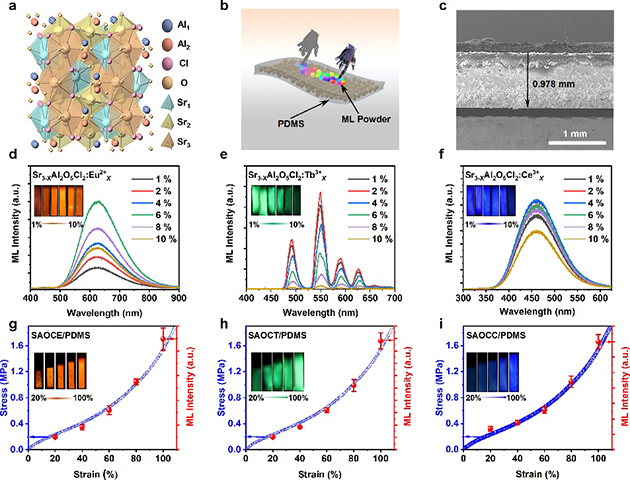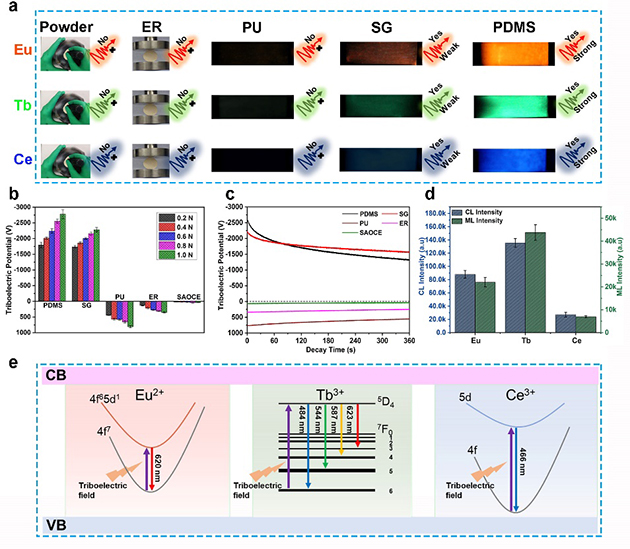Mechanoluminescence (ML) is a type of luminescence that can convert the mechanics into light. Because of its unique characteristics, such as mechanics visualization and spatial resolution, ML provides novel thoughts to deal with the critical problems in mechanics sensing. To grasp and master the essence of ML and guide its future design and applications, it is highly required to understand the intrinsic physics processes.
Prof. WANG Zhaofeng’s group at the Lanzhou Institute of Chemical Physics of the Chinese Academy of Sciences reports a novel non-piezoelectrical ML system, Sr3Al2O5Cl2:Ln (SAOCL; Ln=Eu2+, Tb3+, Ce3+). The materials have high crystal symmetry with no ML in the form of powders or the composite with hard epoxy resin. However, intense ML with tri-color can be obtained when the materials embedded into polydimethylsiloxane (PDMS), as shown in Figure 1.

Figure 1. Structure and non-piezoelectrical ML of SAOCL
The ML of SAOCL/PDMS is trap-independent with unique temperature-modulated self-recoverable activity. It suggests that there should be self-activation during ML, namely, the electrons in the structure could be self-activated to the excited levels under mechanics stimuli.
To further make clear the mechanics-excitation processes, the team proposes an interfacial triboelectrification-induced electron bombardment model by comprehensively analyzing the thermoluminescence, triboelectricity and matrix effects. The consistency between the mechanoluminescence and cathodoluminescence provides direct evidence for the above mechanism (Figure 2).

Figure 2. Matrix effects and the non-piezoelectrical ML processes of SAOCL
Because of the unique physics processes, the ML of SAOCL/PDMS exhibits attractive thermal stability that the conventional ML materials do not possess. By utilizing the trap-independent, self-recoverable and thermally stable behaviors of the ML of SAOCL/PDMS, the team develops two types of advanced devices in terms of the visualized temperature sensing and the multi-mode information storage.
This work provides a comprehensive and deep investigation on the non-piezoelectrical ML from fundamentals to device applications, which should be valuable for the future ML design and applications.
These findings are described in the article entitled “Interfacial triboelectrification-modulated self-recoverable and thermally stable mechanoluminescence in mixed-anion compounds”, recently published in Nano Energy (Nano Energy, 2022, 96, 107075). The first author of this paper is BAI Yongqing, a Ph.D. candidate at University of Chinese Academy of Sciences. The corresponding author is Prof. WANG Zhaofeng .
This work was supported by the Natural Science Foundation for Distinguished Young Scholars of Gansu Province, the National Natural Science Foundation of China, and the Key Research Program of the Chinese Academy of Sciences.
Contact:
Wang Zhaofeng
Email: zhfwang@licp.cas.cn
Lanzhou Institute of Chemical Physics


